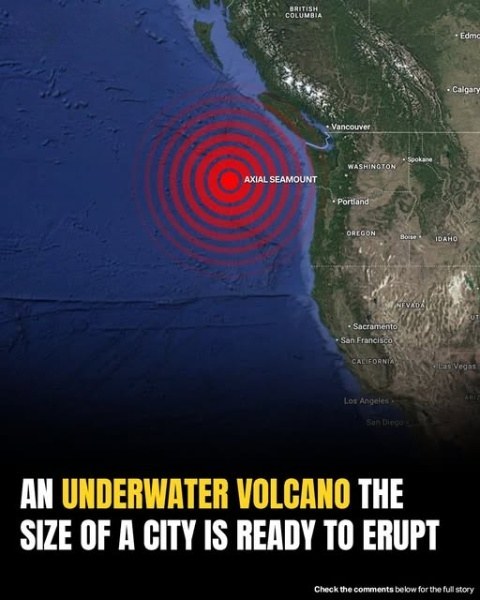According to geologists, a massive underwater volcano located hundreds of miles off the coast of Oregon is now showing strong signs of an impending eruption. This alarming activity has captured the attention of scientists monitoring the region, as seismic signals suggest a growing buildup of pressure beneath the ocean floor.
The volcano, known as Axial Seamount, lies nearly a mile (about 1.4 kilometers) beneath the surface of the Pacific Ocean. It is positioned directly over a geological hot spot—an area where molten rock from deep within the Earth’s mantle rises and forces its way into the crust. These kinds of underwater volcanoes are not uncommon in such hot zones, but Axial Seamount is unique in that it also sits atop the Juan de Fuca Ridge—a mid-ocean ridge where two major tectonic plates, the Pacific Plate and the Juan de Fuca Plate, are slowly and continuously pulling away from each other.
This plate separation creates an ideal environment for volcanic activity, as the stretching of the crust allows magma to accumulate more easily beneath the surface. The persistent movement of these tectonic plates increases the internal pressure over time, making eruptions not only more likely but also harder to predict with precision.
Researchers at the Ocean Observatories Initiative’s Regional Cabled Array—a project funded by the National Science Foundation and operated by the University of Washington—have been closely monitoring Axial Seamount’s behavior. Using deep-sea instruments and advanced data transmission systems, they have detected a significant uptick in the number of earthquakes occurring near the volcano. This seismic increase is a classic indication that magma is actively forcing its way upward, causing the volcano to “inflate,” or swell, from internal pressure—an early sign that an eruption could be approaching.
Currently, the area is experiencing several hundred small earthquakes per day, according to William Wilcock, a marine geophysicist and professor at the University of Washington’s School of Oceanography. While this number is concerning, it is still lower than the seismic swarm that preceded the volcano’s most recent eruption.
“In terms of earthquake activity, we’re seeing a couple hundred tremors daily,” Wilcock said. “That’s still less intense than what we observed just before the last eruption, but it’s definitely notable.”
Wilcock emphasized the uncertainty surrounding the timing of the eruption. “I’d estimate that Axial Seamount will likely erupt sometime later this year or possibly in early 2026,” he explained. “But in truth, it could happen tomorrow. These systems are inherently unpredictable.”
The growing activity at Axial Seamount serves as a reminder of the dynamic nature of our planet’s geology—and how even remote regions of the seafloor can have powerful, potentially far-reaching consequences. Scientists will continue to monitor the situation closely in the weeks and months ahead.
